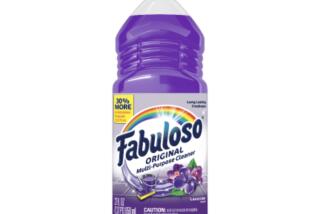Tylenol Held Tainted After Leaving Plant
- Share via
WASHINGTON — The FBI said Wednesday that it has found evidence of tampering “after the packaging was complete” with the two bottles of poisoned Tylenol found in Westchester County, N.Y., one of which caused the death of a woman nearly three weeks ago.
The bureau said that “sophisticated scientific examinations” conducted in its laboratory have uncovered signs of tampering that were “previously undetected” in its earlier analysis of the suspect bottles of Extra-Strength Tylenol capsules.
“It was possible to invade the bottles after packaging was complete without detection through conventional means of examination,” the agency said, presumably meaning that the bottles’ tamper-resistant seals could have been tampered with and replaced without subsequent detection by consumers.
Protect Investigation
FBI officials declined to reveal what they had found in their Washington-based laboratory examination that convinced them that tampering had occurred. “We don’t want to lay out evidence injurious to our investigation,” a spokesman said.
On Feb. 8, cyanide-laced Tylenol capsules killed Diane Elsroth, a 23-year-old Peekskill, N.Y., woman who died at the home of her Yonkers boyfriend. Several days later, a second bottle of poisoned Tylenol capsules was found in a Bronxville store less than two blocks from the A&P; market where the first bottle had been purchased. The second bottle, confiscated from a Woolworth’s store, was found with all three tamper-resistant package seals seemingly intact, baffling investigators as to how the tampering had taken place.
The bureau’s earlier statement that it had uncovered no evidence of tampering was based on conventional means of examination, the spokesman explained. Since then, FBI lab technicians have had more time to study the manufacturing and packaging processes and to conduct much more sophisticated tests.
The latest comments, made in response to inquiries, add considerable weight to the conclusion that the cyanide was not placed in the capsules during the manufacturing process.
“While we can’t positively rule out any investigative theory, it certainly supports the investigative theory that it was done after the Tylenol left the factory,” the spokesman said.
Seals Could Be Replaced
It was learned from other sources that FBI lab technicians established some time ago that the container’s three seals could be removed and replaced in less than an hour in a manner that would escape conventional detection.
The two bottles came from different lots and were produced in different plants, the first in Fort Washington, Pa., the second in Puerto Rico. Because of this--and because the bottles were found in such close proximity--the Food and Drug Administration and Tylenol manufacturer Johnson & Johnson both theorized that the contamination occurred “locally” in Westchester County.
“The FBI statement supports what we have believed all along--that the tampering took place after it left the plant,” said Lawrence Foster, a spokesman for Johnson & Johnson.
The tamper-resistant packages were designed in 1982 after cyanide-laced Extra-Strength Tylenol killed seven persons in the Chicago area. No one has been charged in the Chicago slayings. Laboratory analysis has proved that the cyanide in the New York death was different from that used in the Chicago murders.
Meanwhile, in Nashville, Tenn., a medical examiner ruled Wednesday that 33-year-old Timothy Green, an ailing musician and door-to-door preacher found dead with a single capsule of Extra-Strength Tylenol under his bed, died from a massive dose of cyanide.
20 Times Lethal Dose
Medical Examiner Charles Harland said the level of cyanide found in Green’s body was 20 times the lethal dose, but he stopped short of saying that the poison came from a Tylenol capsule.
“At this time, we have not determined where the cyanide came from,” he said. He told reporters, however, that the Tylenol bottle “smelled of cyanide, and there were traces of material that appeared to be cyanide” in the lone remaining capsule.
Harland indicated that the capsule, now at the state crime laboratory, would be turned over to the FDA for testing.
He said tests on Green’s remains were negative for alcohol and drugs--including acetaminophen, the active ingredient in Tylenol. That meant, Harland said, that Green “did not take a Tylenol, or the Tylenol could have been removed from the capsule and replaced with cyanide.”
More to Read
Inside the business of entertainment
The Wide Shot brings you news, analysis and insights on everything from streaming wars to production — and what it all means for the future.
You may occasionally receive promotional content from the Los Angeles Times.










